HRM Analysis: Marks and Spencer's Human Resource Management Report
VerifiedAdded on 2020/02/05
|15
|5731
|51
Report
AI Summary
This report provides a comprehensive analysis of human resource management (HRM) practices, focusing on Marks and Spencer as a case study. The introduction defines HRM and its significance in organizations, highlighting the roles of HR managers in areas like staffing, employee welfare, and productivity enhancement. Task 1 compares personnel management and HRM, contrasting Aldi Stores' traditional approach with Marks and Spencer's modern HRM strategies. It explores the role of HRM in achieving organizational goals, including resource utilization, goal harmony, and employee satisfaction. Task 2 delves into the importance of HRM planning, outlining its reasons and steps, such as assessing human resources, demand forecasting, and supply forecasting. The report also examines the role of line managers in employee engagement, performance appraisals, and discipline. Furthermore, it emphasizes the legal aspects of HRM, including federal, state, and international laws. Overall, the report provides a detailed overview of HRM principles and their application in a real-world business context, offering valuable insights into effective people management strategies and their impact on organizational success. This report is contributed by a student and available on Desklib, a platform providing AI-based study tools.
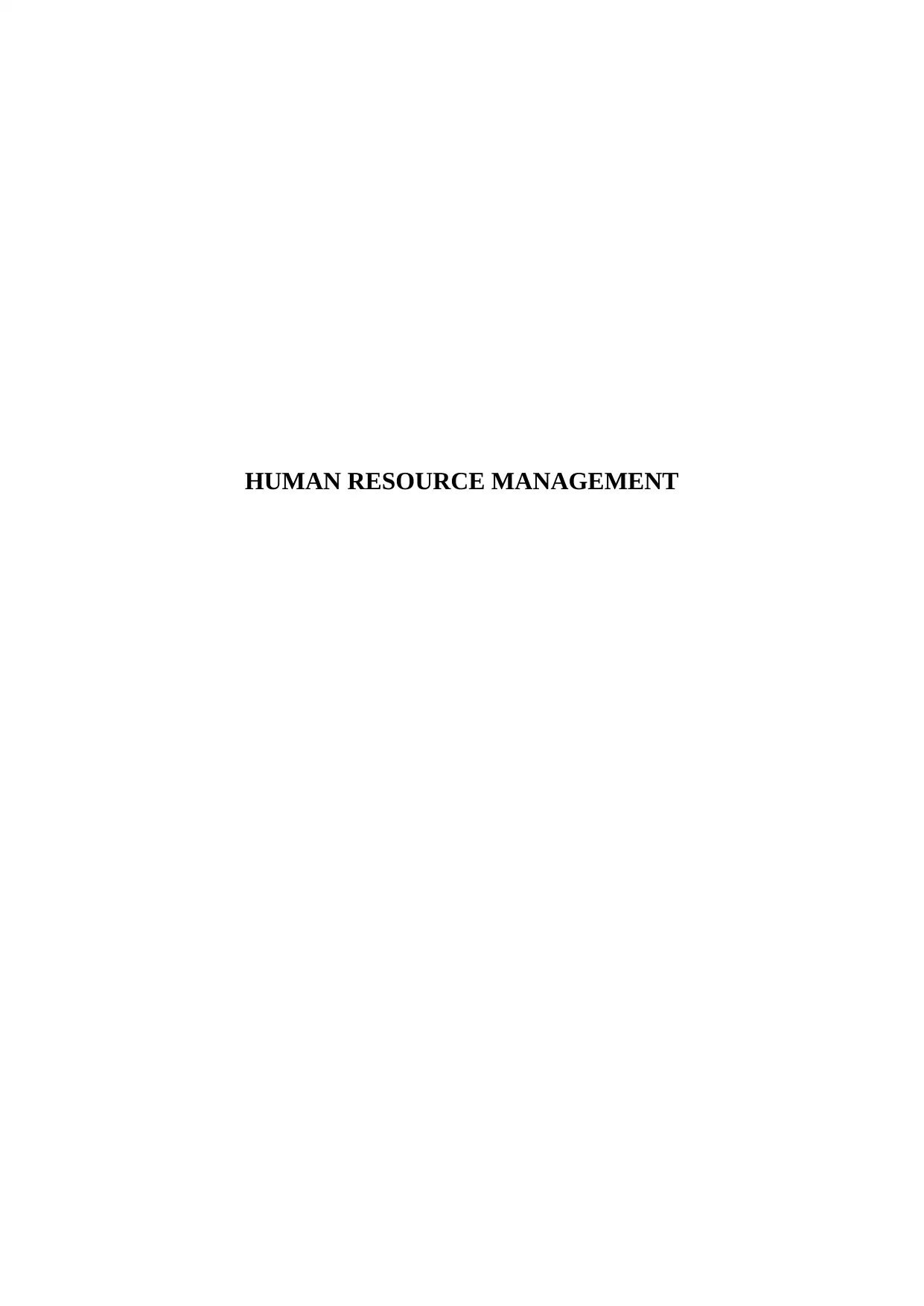
HUMAN RESOURCE MANAGEMENT
Paraphrase This Document
Need a fresh take? Get an instant paraphrase of this document with our AI Paraphraser
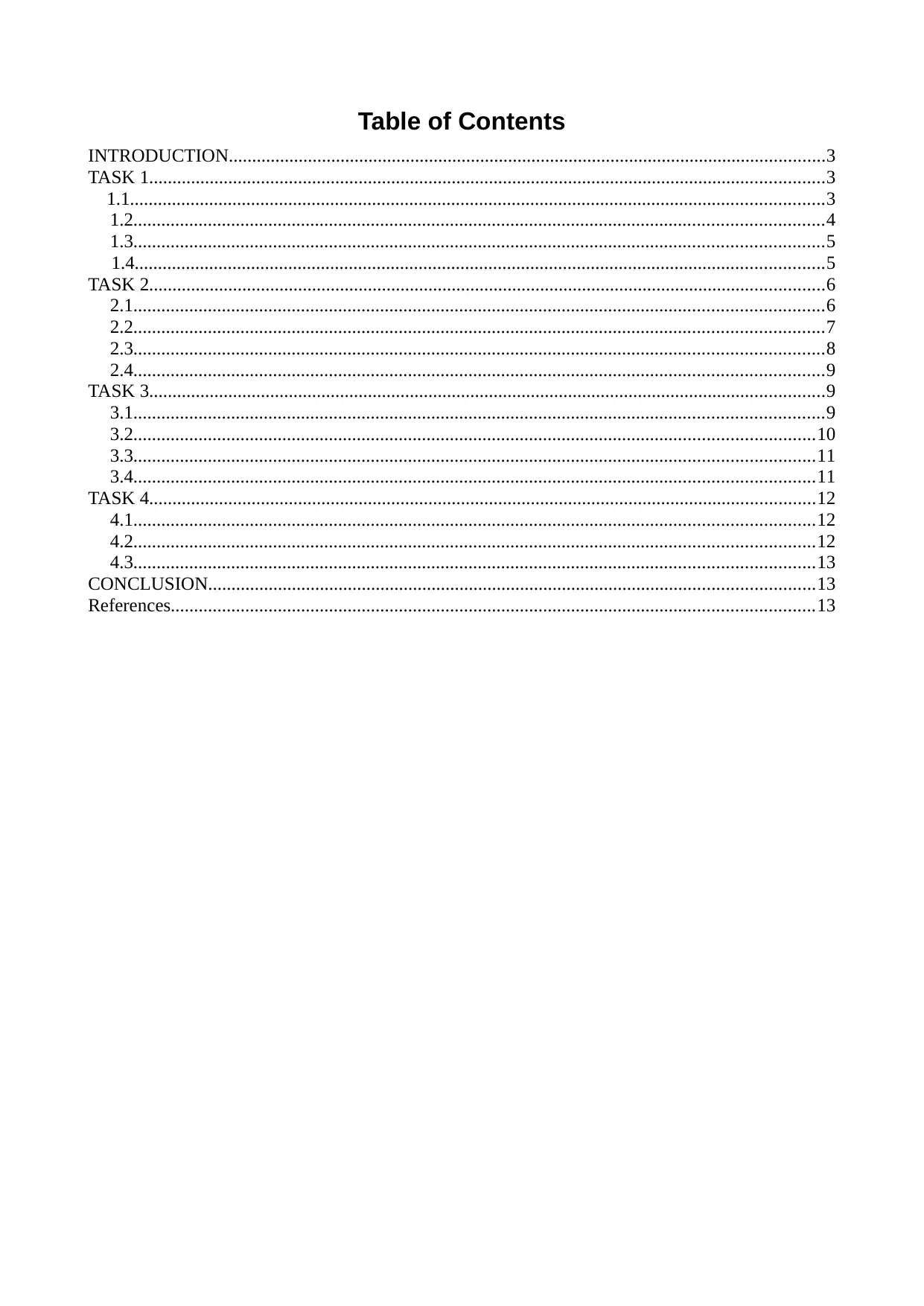
Table of Contents
INTRODUCTION................................................................................................................................3
TASK 1.................................................................................................................................................3
1.1.....................................................................................................................................................3
1.2....................................................................................................................................................4
1.3....................................................................................................................................................5
1.4....................................................................................................................................................5
TASK 2.................................................................................................................................................6
2.1....................................................................................................................................................6
2.2....................................................................................................................................................7
2.3....................................................................................................................................................8
2.4....................................................................................................................................................9
TASK 3.................................................................................................................................................9
3.1....................................................................................................................................................9
3.2..................................................................................................................................................10
3.3..................................................................................................................................................11
3.4..................................................................................................................................................11
TASK 4...............................................................................................................................................12
4.1..................................................................................................................................................12
4.2..................................................................................................................................................12
4.3..................................................................................................................................................13
CONCLUSION..................................................................................................................................13
References..........................................................................................................................................13
INTRODUCTION................................................................................................................................3
TASK 1.................................................................................................................................................3
1.1.....................................................................................................................................................3
1.2....................................................................................................................................................4
1.3....................................................................................................................................................5
1.4....................................................................................................................................................5
TASK 2.................................................................................................................................................6
2.1....................................................................................................................................................6
2.2....................................................................................................................................................7
2.3....................................................................................................................................................8
2.4....................................................................................................................................................9
TASK 3.................................................................................................................................................9
3.1....................................................................................................................................................9
3.2..................................................................................................................................................10
3.3..................................................................................................................................................11
3.4..................................................................................................................................................11
TASK 4...............................................................................................................................................12
4.1..................................................................................................................................................12
4.2..................................................................................................................................................12
4.3..................................................................................................................................................13
CONCLUSION..................................................................................................................................13
References..........................................................................................................................................13
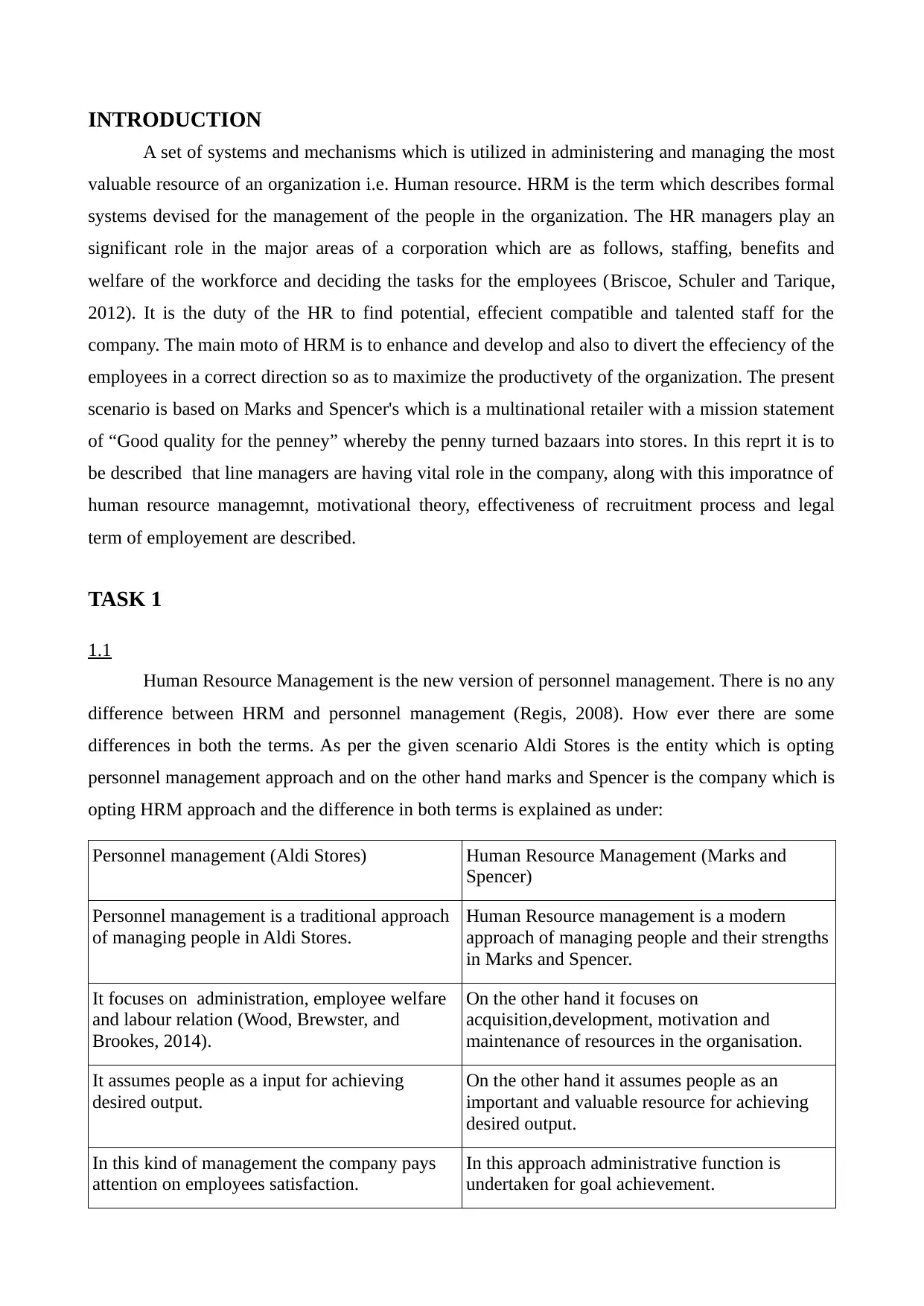
INTRODUCTION
A set of systems and mechanisms which is utilized in administering and managing the most
valuable resource of an organization i.e. Human resource. HRM is the term which describes formal
systems devised for the management of the people in the organization. The HR managers play an
significant role in the major areas of a corporation which are as follows, staffing, benefits and
welfare of the workforce and deciding the tasks for the employees (Briscoe, Schuler and Tarique,
2012). It is the duty of the HR to find potential, effecient compatible and talented staff for the
company. The main moto of HRM is to enhance and develop and also to divert the effeciency of the
employees in a correct direction so as to maximize the productivety of the organization. The present
scenario is based on Marks and Spencer's which is a multinational retailer with a mission statement
of “Good quality for the penney” whereby the penny turned bazaars into stores. In this reprt it is to
be described that line managers are having vital role in the company, along with this imporatnce of
human resource managemnt, motivational theory, effectiveness of recruitment process and legal
term of employement are described.
TASK 1
1.1
Human Resource Management is the new version of personnel management. There is no any
difference between HRM and personnel management (Regis, 2008). How ever there are some
differences in both the terms. As per the given scenario Aldi Stores is the entity which is opting
personnel management approach and on the other hand marks and Spencer is the company which is
opting HRM approach and the difference in both terms is explained as under:
Personnel management (Aldi Stores) Human Resource Management (Marks and
Spencer)
Personnel management is a traditional approach
of managing people in Aldi Stores.
Human Resource management is a modern
approach of managing people and their strengths
in Marks and Spencer.
It focuses on administration, employee welfare
and labour relation (Wood, Brewster, and
Brookes, 2014).
On the other hand it focuses on
acquisition,development, motivation and
maintenance of resources in the organisation.
It assumes people as a input for achieving
desired output.
On the other hand it assumes people as an
important and valuable resource for achieving
desired output.
In this kind of management the company pays
attention on employees satisfaction.
In this approach administrative function is
undertaken for goal achievement.
A set of systems and mechanisms which is utilized in administering and managing the most
valuable resource of an organization i.e. Human resource. HRM is the term which describes formal
systems devised for the management of the people in the organization. The HR managers play an
significant role in the major areas of a corporation which are as follows, staffing, benefits and
welfare of the workforce and deciding the tasks for the employees (Briscoe, Schuler and Tarique,
2012). It is the duty of the HR to find potential, effecient compatible and talented staff for the
company. The main moto of HRM is to enhance and develop and also to divert the effeciency of the
employees in a correct direction so as to maximize the productivety of the organization. The present
scenario is based on Marks and Spencer's which is a multinational retailer with a mission statement
of “Good quality for the penney” whereby the penny turned bazaars into stores. In this reprt it is to
be described that line managers are having vital role in the company, along with this imporatnce of
human resource managemnt, motivational theory, effectiveness of recruitment process and legal
term of employement are described.
TASK 1
1.1
Human Resource Management is the new version of personnel management. There is no any
difference between HRM and personnel management (Regis, 2008). How ever there are some
differences in both the terms. As per the given scenario Aldi Stores is the entity which is opting
personnel management approach and on the other hand marks and Spencer is the company which is
opting HRM approach and the difference in both terms is explained as under:
Personnel management (Aldi Stores) Human Resource Management (Marks and
Spencer)
Personnel management is a traditional approach
of managing people in Aldi Stores.
Human Resource management is a modern
approach of managing people and their strengths
in Marks and Spencer.
It focuses on administration, employee welfare
and labour relation (Wood, Brewster, and
Brookes, 2014).
On the other hand it focuses on
acquisition,development, motivation and
maintenance of resources in the organisation.
It assumes people as a input for achieving
desired output.
On the other hand it assumes people as an
important and valuable resource for achieving
desired output.
In this kind of management the company pays
attention on employees satisfaction.
In this approach administrative function is
undertaken for goal achievement.
⊘ This is a preview!⊘
Do you want full access?
Subscribe today to unlock all pages.

Trusted by 1+ million students worldwide
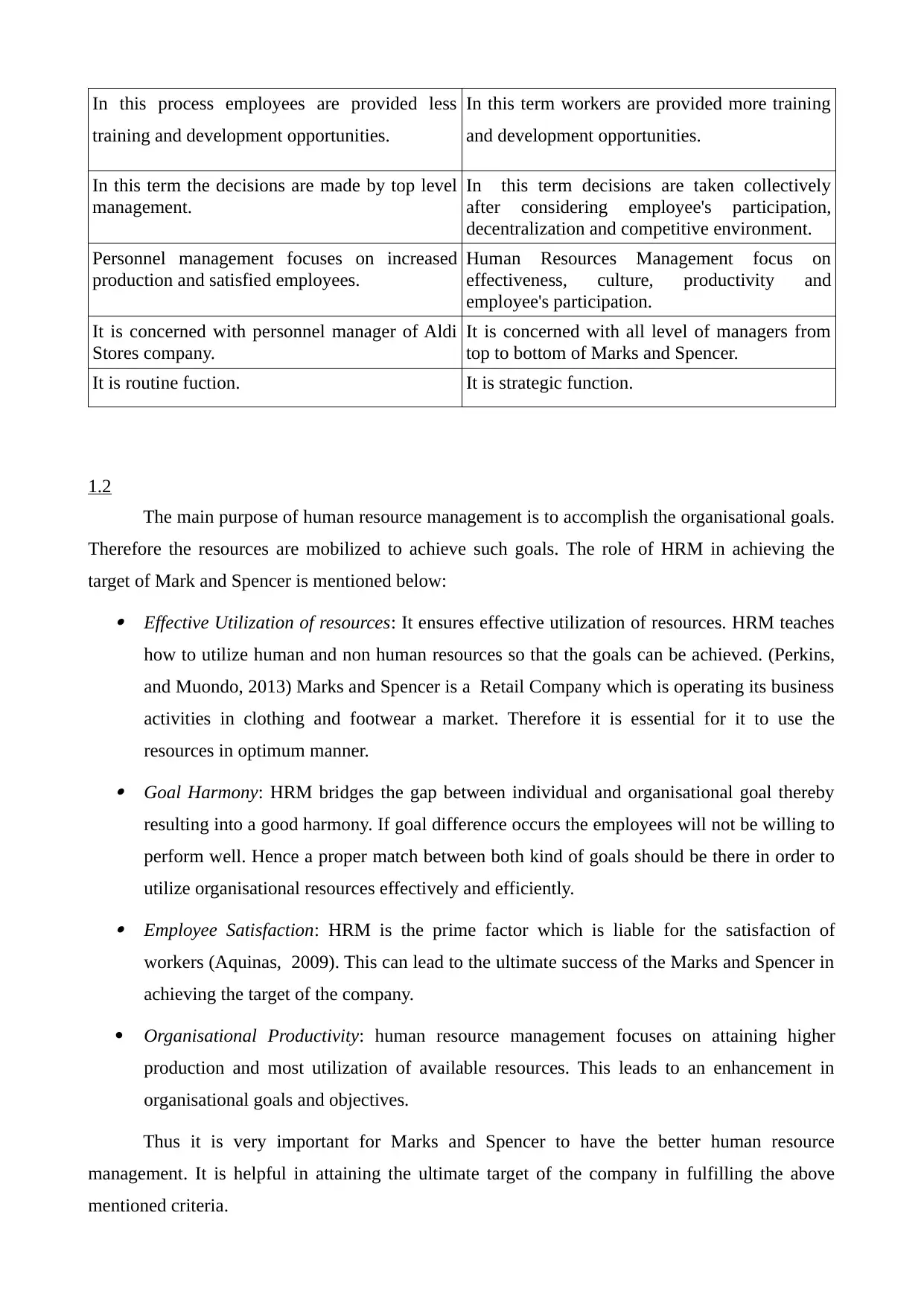
In this process employees are provided less
training and development opportunities.
In this term workers are provided more training
and development opportunities.
In this term the decisions are made by top level
management.
In this term decisions are taken collectively
after considering employee's participation,
decentralization and competitive environment.
Personnel management focuses on increased
production and satisfied employees.
Human Resources Management focus on
effectiveness, culture, productivity and
employee's participation.
It is concerned with personnel manager of Aldi
Stores company.
It is concerned with all level of managers from
top to bottom of Marks and Spencer.
It is routine fuction. It is strategic function.
1.2
The main purpose of human resource management is to accomplish the organisational goals.
Therefore the resources are mobilized to achieve such goals. The role of HRM in achieving the
target of Mark and Spencer is mentioned below:
Effective Utilization of resources: It ensures effective utilization of resources. HRM teaches
how to utilize human and non human resources so that the goals can be achieved. (Perkins,
and Muondo, 2013) Marks and Spencer is a Retail Company which is operating its business
activities in clothing and footwear a market. Therefore it is essential for it to use the
resources in optimum manner.
Goal Harmony: HRM bridges the gap between individual and organisational goal thereby
resulting into a good harmony. If goal difference occurs the employees will not be willing to
perform well. Hence a proper match between both kind of goals should be there in order to
utilize organisational resources effectively and efficiently.
Employee Satisfaction: HRM is the prime factor which is liable for the satisfaction of
workers (Aquinas, 2009). This can lead to the ultimate success of the Marks and Spencer in
achieving the target of the company.
Organisational Productivity: human resource management focuses on attaining higher
production and most utilization of available resources. This leads to an enhancement in
organisational goals and objectives.
Thus it is very important for Marks and Spencer to have the better human resource
management. It is helpful in attaining the ultimate target of the company in fulfilling the above
mentioned criteria.
training and development opportunities.
In this term workers are provided more training
and development opportunities.
In this term the decisions are made by top level
management.
In this term decisions are taken collectively
after considering employee's participation,
decentralization and competitive environment.
Personnel management focuses on increased
production and satisfied employees.
Human Resources Management focus on
effectiveness, culture, productivity and
employee's participation.
It is concerned with personnel manager of Aldi
Stores company.
It is concerned with all level of managers from
top to bottom of Marks and Spencer.
It is routine fuction. It is strategic function.
1.2
The main purpose of human resource management is to accomplish the organisational goals.
Therefore the resources are mobilized to achieve such goals. The role of HRM in achieving the
target of Mark and Spencer is mentioned below:
Effective Utilization of resources: It ensures effective utilization of resources. HRM teaches
how to utilize human and non human resources so that the goals can be achieved. (Perkins,
and Muondo, 2013) Marks and Spencer is a Retail Company which is operating its business
activities in clothing and footwear a market. Therefore it is essential for it to use the
resources in optimum manner.
Goal Harmony: HRM bridges the gap between individual and organisational goal thereby
resulting into a good harmony. If goal difference occurs the employees will not be willing to
perform well. Hence a proper match between both kind of goals should be there in order to
utilize organisational resources effectively and efficiently.
Employee Satisfaction: HRM is the prime factor which is liable for the satisfaction of
workers (Aquinas, 2009). This can lead to the ultimate success of the Marks and Spencer in
achieving the target of the company.
Organisational Productivity: human resource management focuses on attaining higher
production and most utilization of available resources. This leads to an enhancement in
organisational goals and objectives.
Thus it is very important for Marks and Spencer to have the better human resource
management. It is helpful in attaining the ultimate target of the company in fulfilling the above
mentioned criteria.
Paraphrase This Document
Need a fresh take? Get an instant paraphrase of this document with our AI Paraphraser
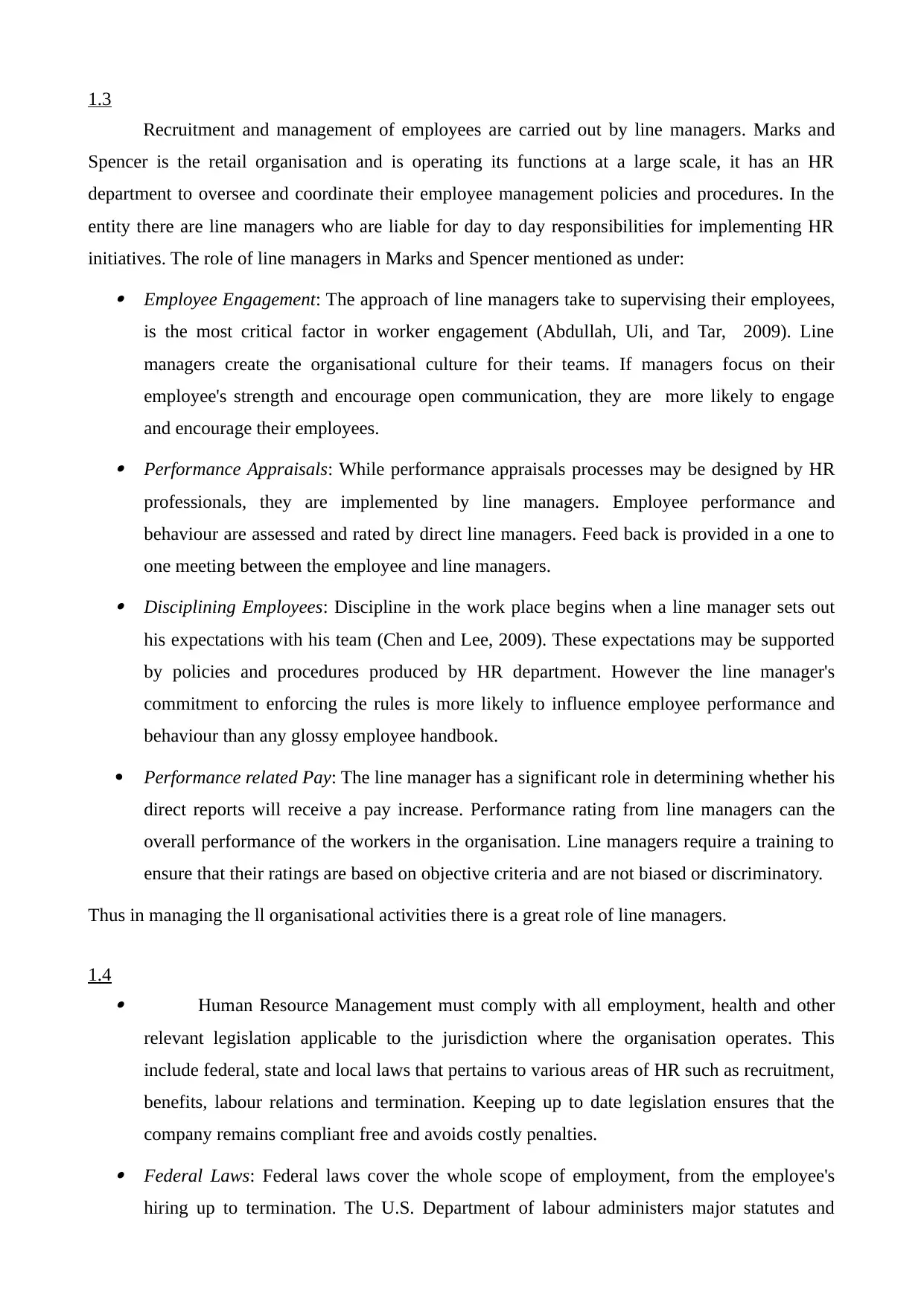
1.3
Recruitment and management of employees are carried out by line managers. Marks and
Spencer is the retail organisation and is operating its functions at a large scale, it has an HR
department to oversee and coordinate their employee management policies and procedures. In the
entity there are line managers who are liable for day to day responsibilities for implementing HR
initiatives. The role of line managers in Marks and Spencer mentioned as under:
Employee Engagement: The approach of line managers take to supervising their employees,
is the most critical factor in worker engagement (Abdullah, Uli, and Tar, 2009). Line
managers create the organisational culture for their teams. If managers focus on their
employee's strength and encourage open communication, they are more likely to engage
and encourage their employees.
Performance Appraisals: While performance appraisals processes may be designed by HR
professionals, they are implemented by line managers. Employee performance and
behaviour are assessed and rated by direct line managers. Feed back is provided in a one to
one meeting between the employee and line managers.
Disciplining Employees: Discipline in the work place begins when a line manager sets out
his expectations with his team (Chen and Lee, 2009). These expectations may be supported
by policies and procedures produced by HR department. However the line manager's
commitment to enforcing the rules is more likely to influence employee performance and
behaviour than any glossy employee handbook.
Performance related Pay: The line manager has a significant role in determining whether his
direct reports will receive a pay increase. Performance rating from line managers can the
overall performance of the workers in the organisation. Line managers require a training to
ensure that their ratings are based on objective criteria and are not biased or discriminatory.
Thus in managing the ll organisational activities there is a great role of line managers.
1.4 Human Resource Management must comply with all employment, health and other
relevant legislation applicable to the jurisdiction where the organisation operates. This
include federal, state and local laws that pertains to various areas of HR such as recruitment,
benefits, labour relations and termination. Keeping up to date legislation ensures that the
company remains compliant free and avoids costly penalties.
Federal Laws: Federal laws cover the whole scope of employment, from the employee's
hiring up to termination. The U.S. Department of labour administers major statutes and
Recruitment and management of employees are carried out by line managers. Marks and
Spencer is the retail organisation and is operating its functions at a large scale, it has an HR
department to oversee and coordinate their employee management policies and procedures. In the
entity there are line managers who are liable for day to day responsibilities for implementing HR
initiatives. The role of line managers in Marks and Spencer mentioned as under:
Employee Engagement: The approach of line managers take to supervising their employees,
is the most critical factor in worker engagement (Abdullah, Uli, and Tar, 2009). Line
managers create the organisational culture for their teams. If managers focus on their
employee's strength and encourage open communication, they are more likely to engage
and encourage their employees.
Performance Appraisals: While performance appraisals processes may be designed by HR
professionals, they are implemented by line managers. Employee performance and
behaviour are assessed and rated by direct line managers. Feed back is provided in a one to
one meeting between the employee and line managers.
Disciplining Employees: Discipline in the work place begins when a line manager sets out
his expectations with his team (Chen and Lee, 2009). These expectations may be supported
by policies and procedures produced by HR department. However the line manager's
commitment to enforcing the rules is more likely to influence employee performance and
behaviour than any glossy employee handbook.
Performance related Pay: The line manager has a significant role in determining whether his
direct reports will receive a pay increase. Performance rating from line managers can the
overall performance of the workers in the organisation. Line managers require a training to
ensure that their ratings are based on objective criteria and are not biased or discriminatory.
Thus in managing the ll organisational activities there is a great role of line managers.
1.4 Human Resource Management must comply with all employment, health and other
relevant legislation applicable to the jurisdiction where the organisation operates. This
include federal, state and local laws that pertains to various areas of HR such as recruitment,
benefits, labour relations and termination. Keeping up to date legislation ensures that the
company remains compliant free and avoids costly penalties.
Federal Laws: Federal laws cover the whole scope of employment, from the employee's
hiring up to termination. The U.S. Department of labour administers major statutes and
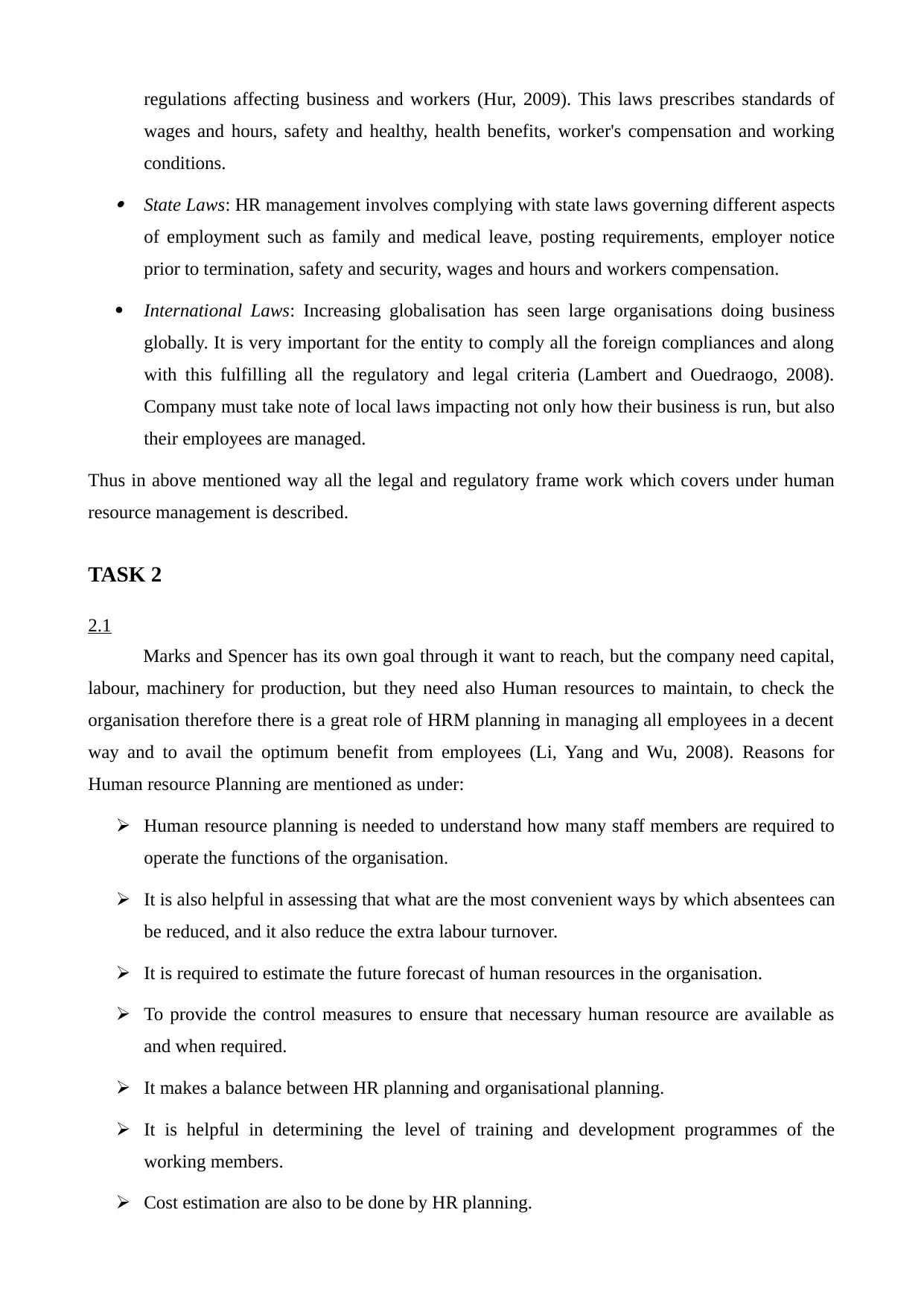
regulations affecting business and workers (Hur, 2009). This laws prescribes standards of
wages and hours, safety and healthy, health benefits, worker's compensation and working
conditions.
State Laws: HR management involves complying with state laws governing different aspects
of employment such as family and medical leave, posting requirements, employer notice
prior to termination, safety and security, wages and hours and workers compensation.
International Laws: Increasing globalisation has seen large organisations doing business
globally. It is very important for the entity to comply all the foreign compliances and along
with this fulfilling all the regulatory and legal criteria (Lambert and Ouedraogo, 2008).
Company must take note of local laws impacting not only how their business is run, but also
their employees are managed.
Thus in above mentioned way all the legal and regulatory frame work which covers under human
resource management is described.
TASK 2
2.1
Marks and Spencer has its own goal through it want to reach, but the company need capital,
labour, machinery for production, but they need also Human resources to maintain, to check the
organisation therefore there is a great role of HRM planning in managing all employees in a decent
way and to avail the optimum benefit from employees (Li, Yang and Wu, 2008). Reasons for
Human resource Planning are mentioned as under:
Human resource planning is needed to understand how many staff members are required to
operate the functions of the organisation.
It is also helpful in assessing that what are the most convenient ways by which absentees can
be reduced, and it also reduce the extra labour turnover.
It is required to estimate the future forecast of human resources in the organisation.
To provide the control measures to ensure that necessary human resource are available as
and when required.
It makes a balance between HR planning and organisational planning.
It is helpful in determining the level of training and development programmes of the
working members.
Cost estimation are also to be done by HR planning.
wages and hours, safety and healthy, health benefits, worker's compensation and working
conditions.
State Laws: HR management involves complying with state laws governing different aspects
of employment such as family and medical leave, posting requirements, employer notice
prior to termination, safety and security, wages and hours and workers compensation.
International Laws: Increasing globalisation has seen large organisations doing business
globally. It is very important for the entity to comply all the foreign compliances and along
with this fulfilling all the regulatory and legal criteria (Lambert and Ouedraogo, 2008).
Company must take note of local laws impacting not only how their business is run, but also
their employees are managed.
Thus in above mentioned way all the legal and regulatory frame work which covers under human
resource management is described.
TASK 2
2.1
Marks and Spencer has its own goal through it want to reach, but the company need capital,
labour, machinery for production, but they need also Human resources to maintain, to check the
organisation therefore there is a great role of HRM planning in managing all employees in a decent
way and to avail the optimum benefit from employees (Li, Yang and Wu, 2008). Reasons for
Human resource Planning are mentioned as under:
Human resource planning is needed to understand how many staff members are required to
operate the functions of the organisation.
It is also helpful in assessing that what are the most convenient ways by which absentees can
be reduced, and it also reduce the extra labour turnover.
It is required to estimate the future forecast of human resources in the organisation.
To provide the control measures to ensure that necessary human resource are available as
and when required.
It makes a balance between HR planning and organisational planning.
It is helpful in determining the level of training and development programmes of the
working members.
Cost estimation are also to be done by HR planning.
⊘ This is a preview!⊘
Do you want full access?
Subscribe today to unlock all pages.

Trusted by 1+ million students worldwide
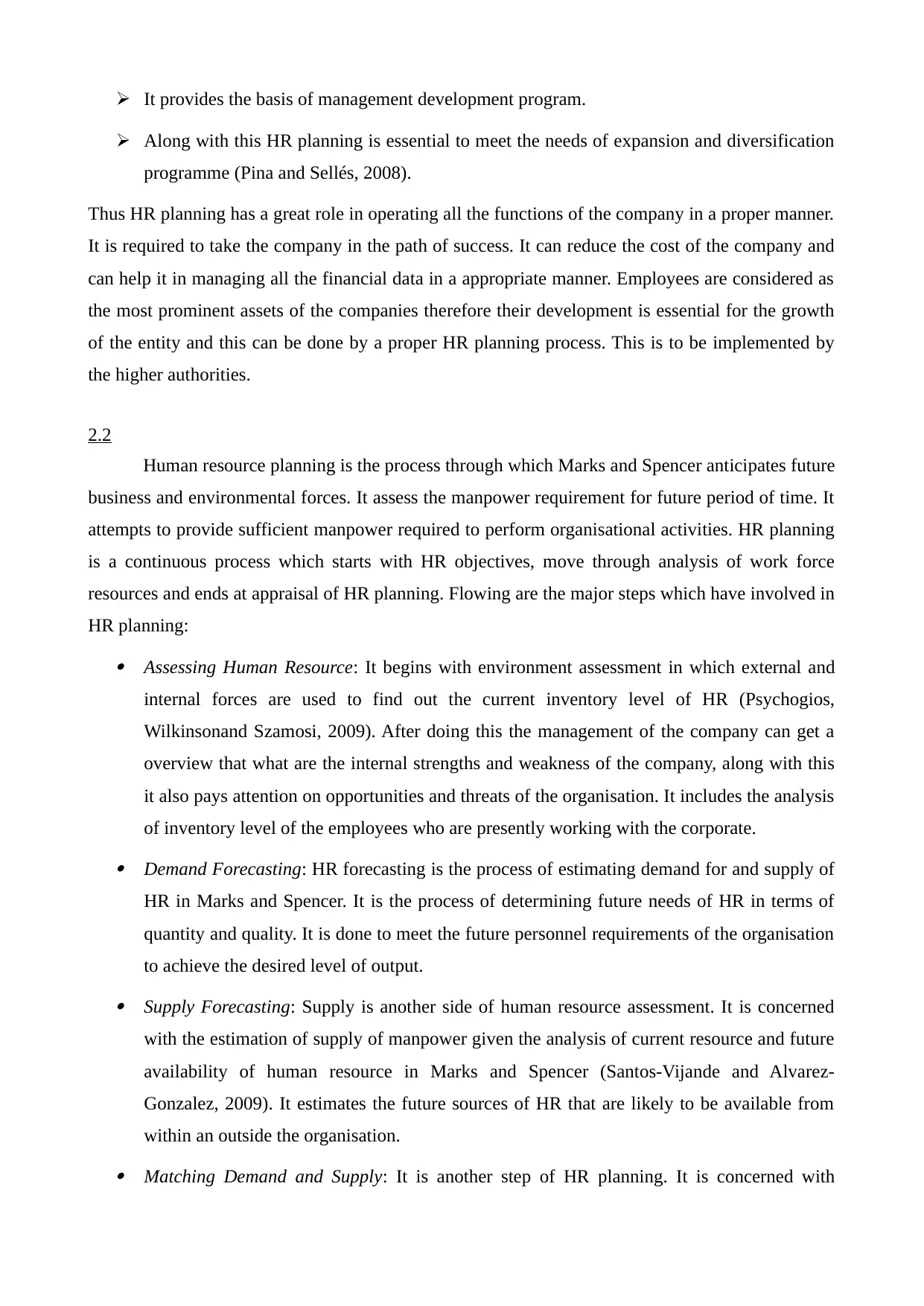
It provides the basis of management development program.
Along with this HR planning is essential to meet the needs of expansion and diversification
programme (Pina and Sellés, 2008).
Thus HR planning has a great role in operating all the functions of the company in a proper manner.
It is required to take the company in the path of success. It can reduce the cost of the company and
can help it in managing all the financial data in a appropriate manner. Employees are considered as
the most prominent assets of the companies therefore their development is essential for the growth
of the entity and this can be done by a proper HR planning process. This is to be implemented by
the higher authorities.
2.2
Human resource planning is the process through which Marks and Spencer anticipates future
business and environmental forces. It assess the manpower requirement for future period of time. It
attempts to provide sufficient manpower required to perform organisational activities. HR planning
is a continuous process which starts with HR objectives, move through analysis of work force
resources and ends at appraisal of HR planning. Flowing are the major steps which have involved in
HR planning:
Assessing Human Resource: It begins with environment assessment in which external and
internal forces are used to find out the current inventory level of HR (Psychogios,
Wilkinsonand Szamosi, 2009). After doing this the management of the company can get a
overview that what are the internal strengths and weakness of the company, along with this
it also pays attention on opportunities and threats of the organisation. It includes the analysis
of inventory level of the employees who are presently working with the corporate.
Demand Forecasting: HR forecasting is the process of estimating demand for and supply of
HR in Marks and Spencer. It is the process of determining future needs of HR in terms of
quantity and quality. It is done to meet the future personnel requirements of the organisation
to achieve the desired level of output.
Supply Forecasting: Supply is another side of human resource assessment. It is concerned
with the estimation of supply of manpower given the analysis of current resource and future
availability of human resource in Marks and Spencer (Santos‐Vijande and Alvarez‐
Gonzalez, 2009). It estimates the future sources of HR that are likely to be available from
within an outside the organisation.
Matching Demand and Supply: It is another step of HR planning. It is concerned with
Along with this HR planning is essential to meet the needs of expansion and diversification
programme (Pina and Sellés, 2008).
Thus HR planning has a great role in operating all the functions of the company in a proper manner.
It is required to take the company in the path of success. It can reduce the cost of the company and
can help it in managing all the financial data in a appropriate manner. Employees are considered as
the most prominent assets of the companies therefore their development is essential for the growth
of the entity and this can be done by a proper HR planning process. This is to be implemented by
the higher authorities.
2.2
Human resource planning is the process through which Marks and Spencer anticipates future
business and environmental forces. It assess the manpower requirement for future period of time. It
attempts to provide sufficient manpower required to perform organisational activities. HR planning
is a continuous process which starts with HR objectives, move through analysis of work force
resources and ends at appraisal of HR planning. Flowing are the major steps which have involved in
HR planning:
Assessing Human Resource: It begins with environment assessment in which external and
internal forces are used to find out the current inventory level of HR (Psychogios,
Wilkinsonand Szamosi, 2009). After doing this the management of the company can get a
overview that what are the internal strengths and weakness of the company, along with this
it also pays attention on opportunities and threats of the organisation. It includes the analysis
of inventory level of the employees who are presently working with the corporate.
Demand Forecasting: HR forecasting is the process of estimating demand for and supply of
HR in Marks and Spencer. It is the process of determining future needs of HR in terms of
quantity and quality. It is done to meet the future personnel requirements of the organisation
to achieve the desired level of output.
Supply Forecasting: Supply is another side of human resource assessment. It is concerned
with the estimation of supply of manpower given the analysis of current resource and future
availability of human resource in Marks and Spencer (Santos‐Vijande and Alvarez‐
Gonzalez, 2009). It estimates the future sources of HR that are likely to be available from
within an outside the organisation.
Matching Demand and Supply: It is another step of HR planning. It is concerned with
Paraphrase This Document
Need a fresh take? Get an instant paraphrase of this document with our AI Paraphraser
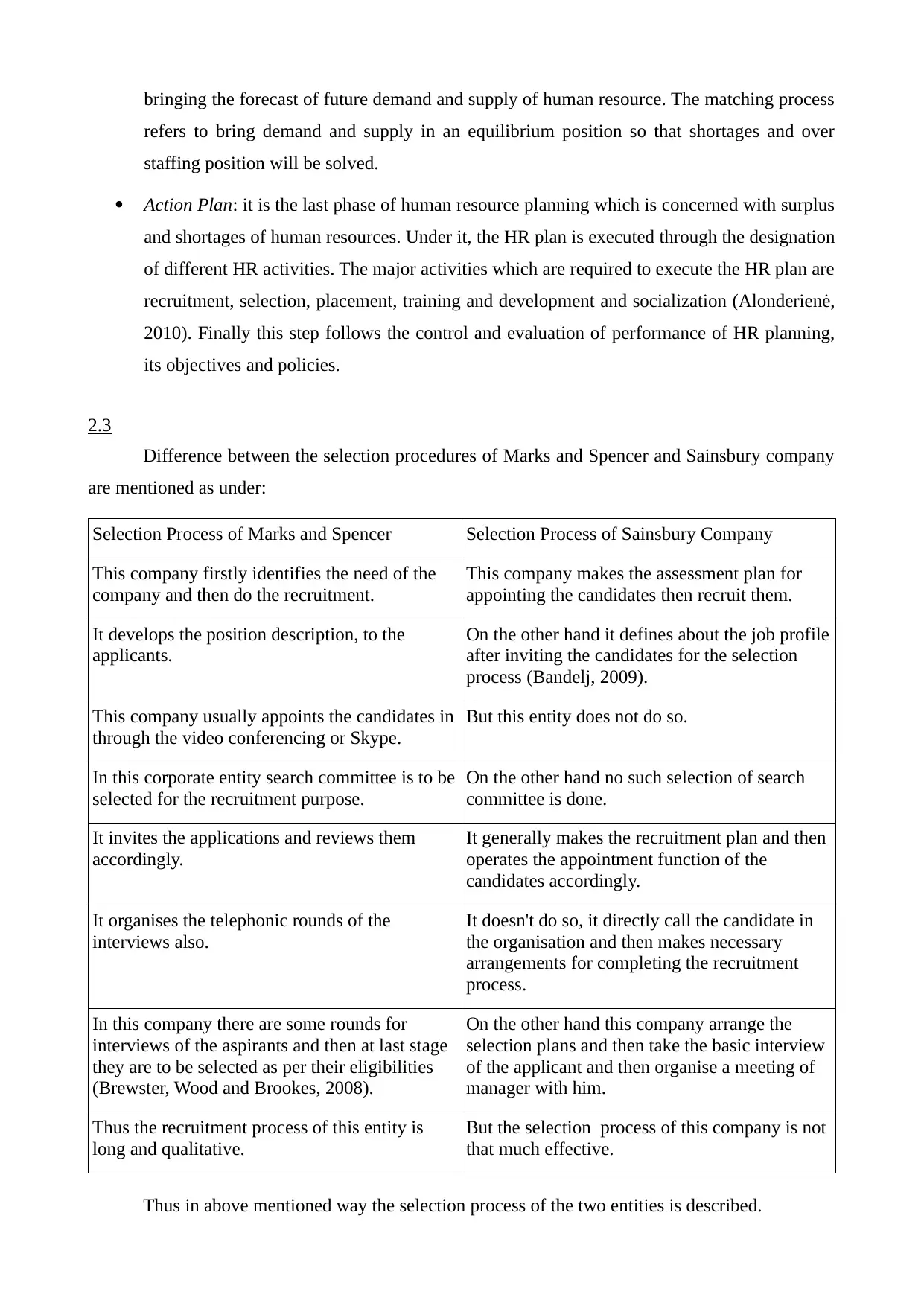
bringing the forecast of future demand and supply of human resource. The matching process
refers to bring demand and supply in an equilibrium position so that shortages and over
staffing position will be solved.
Action Plan: it is the last phase of human resource planning which is concerned with surplus
and shortages of human resources. Under it, the HR plan is executed through the designation
of different HR activities. The major activities which are required to execute the HR plan are
recruitment, selection, placement, training and development and socialization (Alonderienė,
2010). Finally this step follows the control and evaluation of performance of HR planning,
its objectives and policies.
2.3
Difference between the selection procedures of Marks and Spencer and Sainsbury company
are mentioned as under:
Selection Process of Marks and Spencer Selection Process of Sainsbury Company
This company firstly identifies the need of the
company and then do the recruitment.
This company makes the assessment plan for
appointing the candidates then recruit them.
It develops the position description, to the
applicants.
On the other hand it defines about the job profile
after inviting the candidates for the selection
process (Bandelj, 2009).
This company usually appoints the candidates in
through the video conferencing or Skype.
But this entity does not do so.
In this corporate entity search committee is to be
selected for the recruitment purpose.
On the other hand no such selection of search
committee is done.
It invites the applications and reviews them
accordingly.
It generally makes the recruitment plan and then
operates the appointment function of the
candidates accordingly.
It organises the telephonic rounds of the
interviews also.
It doesn't do so, it directly call the candidate in
the organisation and then makes necessary
arrangements for completing the recruitment
process.
In this company there are some rounds for
interviews of the aspirants and then at last stage
they are to be selected as per their eligibilities
(Brewster, Wood and Brookes, 2008).
On the other hand this company arrange the
selection plans and then take the basic interview
of the applicant and then organise a meeting of
manager with him.
Thus the recruitment process of this entity is
long and qualitative.
But the selection process of this company is not
that much effective.
Thus in above mentioned way the selection process of the two entities is described.
refers to bring demand and supply in an equilibrium position so that shortages and over
staffing position will be solved.
Action Plan: it is the last phase of human resource planning which is concerned with surplus
and shortages of human resources. Under it, the HR plan is executed through the designation
of different HR activities. The major activities which are required to execute the HR plan are
recruitment, selection, placement, training and development and socialization (Alonderienė,
2010). Finally this step follows the control and evaluation of performance of HR planning,
its objectives and policies.
2.3
Difference between the selection procedures of Marks and Spencer and Sainsbury company
are mentioned as under:
Selection Process of Marks and Spencer Selection Process of Sainsbury Company
This company firstly identifies the need of the
company and then do the recruitment.
This company makes the assessment plan for
appointing the candidates then recruit them.
It develops the position description, to the
applicants.
On the other hand it defines about the job profile
after inviting the candidates for the selection
process (Bandelj, 2009).
This company usually appoints the candidates in
through the video conferencing or Skype.
But this entity does not do so.
In this corporate entity search committee is to be
selected for the recruitment purpose.
On the other hand no such selection of search
committee is done.
It invites the applications and reviews them
accordingly.
It generally makes the recruitment plan and then
operates the appointment function of the
candidates accordingly.
It organises the telephonic rounds of the
interviews also.
It doesn't do so, it directly call the candidate in
the organisation and then makes necessary
arrangements for completing the recruitment
process.
In this company there are some rounds for
interviews of the aspirants and then at last stage
they are to be selected as per their eligibilities
(Brewster, Wood and Brookes, 2008).
On the other hand this company arrange the
selection plans and then take the basic interview
of the applicant and then organise a meeting of
manager with him.
Thus the recruitment process of this entity is
long and qualitative.
But the selection process of this company is not
that much effective.
Thus in above mentioned way the selection process of the two entities is described.
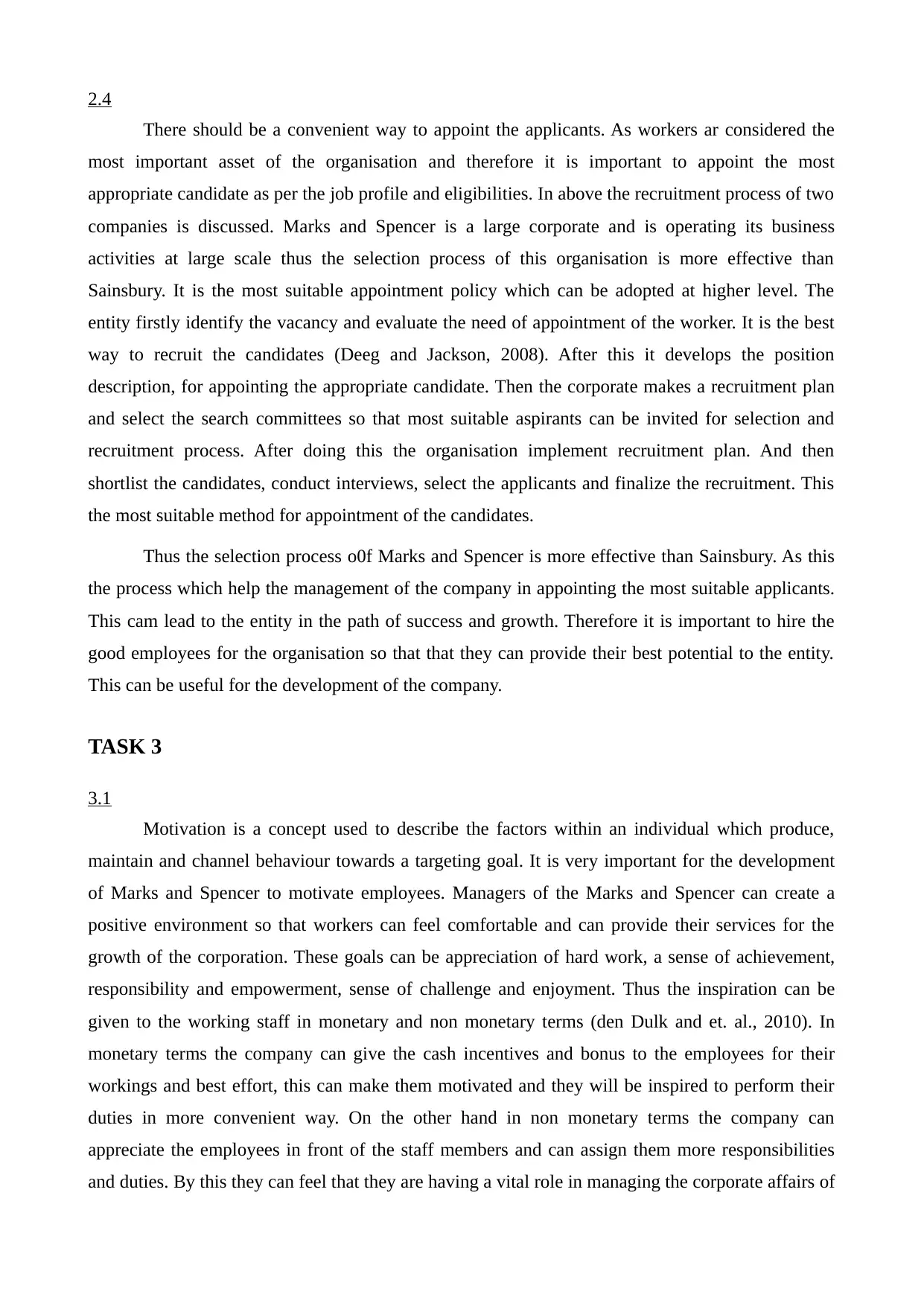
2.4
There should be a convenient way to appoint the applicants. As workers ar considered the
most important asset of the organisation and therefore it is important to appoint the most
appropriate candidate as per the job profile and eligibilities. In above the recruitment process of two
companies is discussed. Marks and Spencer is a large corporate and is operating its business
activities at large scale thus the selection process of this organisation is more effective than
Sainsbury. It is the most suitable appointment policy which can be adopted at higher level. The
entity firstly identify the vacancy and evaluate the need of appointment of the worker. It is the best
way to recruit the candidates (Deeg and Jackson, 2008). After this it develops the position
description, for appointing the appropriate candidate. Then the corporate makes a recruitment plan
and select the search committees so that most suitable aspirants can be invited for selection and
recruitment process. After doing this the organisation implement recruitment plan. And then
shortlist the candidates, conduct interviews, select the applicants and finalize the recruitment. This
the most suitable method for appointment of the candidates.
Thus the selection process o0f Marks and Spencer is more effective than Sainsbury. As this
the process which help the management of the company in appointing the most suitable applicants.
This cam lead to the entity in the path of success and growth. Therefore it is important to hire the
good employees for the organisation so that that they can provide their best potential to the entity.
This can be useful for the development of the company.
TASK 3
3.1
Motivation is a concept used to describe the factors within an individual which produce,
maintain and channel behaviour towards a targeting goal. It is very important for the development
of Marks and Spencer to motivate employees. Managers of the Marks and Spencer can create a
positive environment so that workers can feel comfortable and can provide their services for the
growth of the corporation. These goals can be appreciation of hard work, a sense of achievement,
responsibility and empowerment, sense of challenge and enjoyment. Thus the inspiration can be
given to the working staff in monetary and non monetary terms (den Dulk and et. al., 2010). In
monetary terms the company can give the cash incentives and bonus to the employees for their
workings and best effort, this can make them motivated and they will be inspired to perform their
duties in more convenient way. On the other hand in non monetary terms the company can
appreciate the employees in front of the staff members and can assign them more responsibilities
and duties. By this they can feel that they are having a vital role in managing the corporate affairs of
There should be a convenient way to appoint the applicants. As workers ar considered the
most important asset of the organisation and therefore it is important to appoint the most
appropriate candidate as per the job profile and eligibilities. In above the recruitment process of two
companies is discussed. Marks and Spencer is a large corporate and is operating its business
activities at large scale thus the selection process of this organisation is more effective than
Sainsbury. It is the most suitable appointment policy which can be adopted at higher level. The
entity firstly identify the vacancy and evaluate the need of appointment of the worker. It is the best
way to recruit the candidates (Deeg and Jackson, 2008). After this it develops the position
description, for appointing the appropriate candidate. Then the corporate makes a recruitment plan
and select the search committees so that most suitable aspirants can be invited for selection and
recruitment process. After doing this the organisation implement recruitment plan. And then
shortlist the candidates, conduct interviews, select the applicants and finalize the recruitment. This
the most suitable method for appointment of the candidates.
Thus the selection process o0f Marks and Spencer is more effective than Sainsbury. As this
the process which help the management of the company in appointing the most suitable applicants.
This cam lead to the entity in the path of success and growth. Therefore it is important to hire the
good employees for the organisation so that that they can provide their best potential to the entity.
This can be useful for the development of the company.
TASK 3
3.1
Motivation is a concept used to describe the factors within an individual which produce,
maintain and channel behaviour towards a targeting goal. It is very important for the development
of Marks and Spencer to motivate employees. Managers of the Marks and Spencer can create a
positive environment so that workers can feel comfortable and can provide their services for the
growth of the corporation. These goals can be appreciation of hard work, a sense of achievement,
responsibility and empowerment, sense of challenge and enjoyment. Thus the inspiration can be
given to the working staff in monetary and non monetary terms (den Dulk and et. al., 2010). In
monetary terms the company can give the cash incentives and bonus to the employees for their
workings and best effort, this can make them motivated and they will be inspired to perform their
duties in more convenient way. On the other hand in non monetary terms the company can
appreciate the employees in front of the staff members and can assign them more responsibilities
and duties. By this they can feel that they are having a vital role in managing the corporate affairs of
⊘ This is a preview!⊘
Do you want full access?
Subscribe today to unlock all pages.

Trusted by 1+ million students worldwide
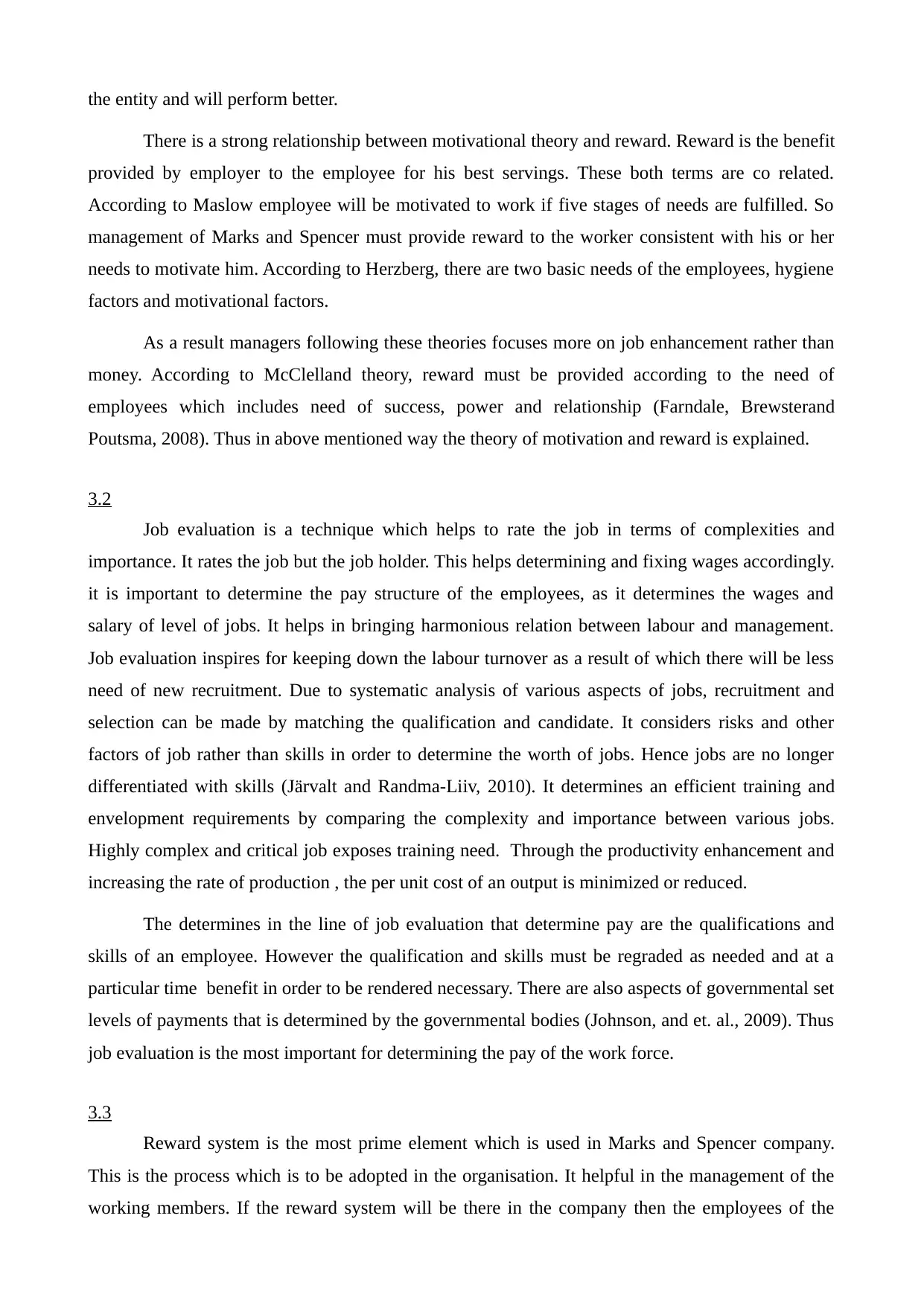
the entity and will perform better.
There is a strong relationship between motivational theory and reward. Reward is the benefit
provided by employer to the employee for his best servings. These both terms are co related.
According to Maslow employee will be motivated to work if five stages of needs are fulfilled. So
management of Marks and Spencer must provide reward to the worker consistent with his or her
needs to motivate him. According to Herzberg, there are two basic needs of the employees, hygiene
factors and motivational factors.
As a result managers following these theories focuses more on job enhancement rather than
money. According to McClelland theory, reward must be provided according to the need of
employees which includes need of success, power and relationship (Farndale, Brewsterand
Poutsma, 2008). Thus in above mentioned way the theory of motivation and reward is explained.
3.2
Job evaluation is a technique which helps to rate the job in terms of complexities and
importance. It rates the job but the job holder. This helps determining and fixing wages accordingly.
it is important to determine the pay structure of the employees, as it determines the wages and
salary of level of jobs. It helps in bringing harmonious relation between labour and management.
Job evaluation inspires for keeping down the labour turnover as a result of which there will be less
need of new recruitment. Due to systematic analysis of various aspects of jobs, recruitment and
selection can be made by matching the qualification and candidate. It considers risks and other
factors of job rather than skills in order to determine the worth of jobs. Hence jobs are no longer
differentiated with skills (Järvalt and Randma‐Liiv, 2010). It determines an efficient training and
envelopment requirements by comparing the complexity and importance between various jobs.
Highly complex and critical job exposes training need. Through the productivity enhancement and
increasing the rate of production , the per unit cost of an output is minimized or reduced.
The determines in the line of job evaluation that determine pay are the qualifications and
skills of an employee. However the qualification and skills must be regraded as needed and at a
particular time benefit in order to be rendered necessary. There are also aspects of governmental set
levels of payments that is determined by the governmental bodies (Johnson, and et. al., 2009). Thus
job evaluation is the most important for determining the pay of the work force.
3.3
Reward system is the most prime element which is used in Marks and Spencer company.
This is the process which is to be adopted in the organisation. It helpful in the management of the
working members. If the reward system will be there in the company then the employees of the
There is a strong relationship between motivational theory and reward. Reward is the benefit
provided by employer to the employee for his best servings. These both terms are co related.
According to Maslow employee will be motivated to work if five stages of needs are fulfilled. So
management of Marks and Spencer must provide reward to the worker consistent with his or her
needs to motivate him. According to Herzberg, there are two basic needs of the employees, hygiene
factors and motivational factors.
As a result managers following these theories focuses more on job enhancement rather than
money. According to McClelland theory, reward must be provided according to the need of
employees which includes need of success, power and relationship (Farndale, Brewsterand
Poutsma, 2008). Thus in above mentioned way the theory of motivation and reward is explained.
3.2
Job evaluation is a technique which helps to rate the job in terms of complexities and
importance. It rates the job but the job holder. This helps determining and fixing wages accordingly.
it is important to determine the pay structure of the employees, as it determines the wages and
salary of level of jobs. It helps in bringing harmonious relation between labour and management.
Job evaluation inspires for keeping down the labour turnover as a result of which there will be less
need of new recruitment. Due to systematic analysis of various aspects of jobs, recruitment and
selection can be made by matching the qualification and candidate. It considers risks and other
factors of job rather than skills in order to determine the worth of jobs. Hence jobs are no longer
differentiated with skills (Järvalt and Randma‐Liiv, 2010). It determines an efficient training and
envelopment requirements by comparing the complexity and importance between various jobs.
Highly complex and critical job exposes training need. Through the productivity enhancement and
increasing the rate of production , the per unit cost of an output is minimized or reduced.
The determines in the line of job evaluation that determine pay are the qualifications and
skills of an employee. However the qualification and skills must be regraded as needed and at a
particular time benefit in order to be rendered necessary. There are also aspects of governmental set
levels of payments that is determined by the governmental bodies (Johnson, and et. al., 2009). Thus
job evaluation is the most important for determining the pay of the work force.
3.3
Reward system is the most prime element which is used in Marks and Spencer company.
This is the process which is to be adopted in the organisation. It helpful in the management of the
working members. If the reward system will be there in the company then the employees of the
Paraphrase This Document
Need a fresh take? Get an instant paraphrase of this document with our AI Paraphraser
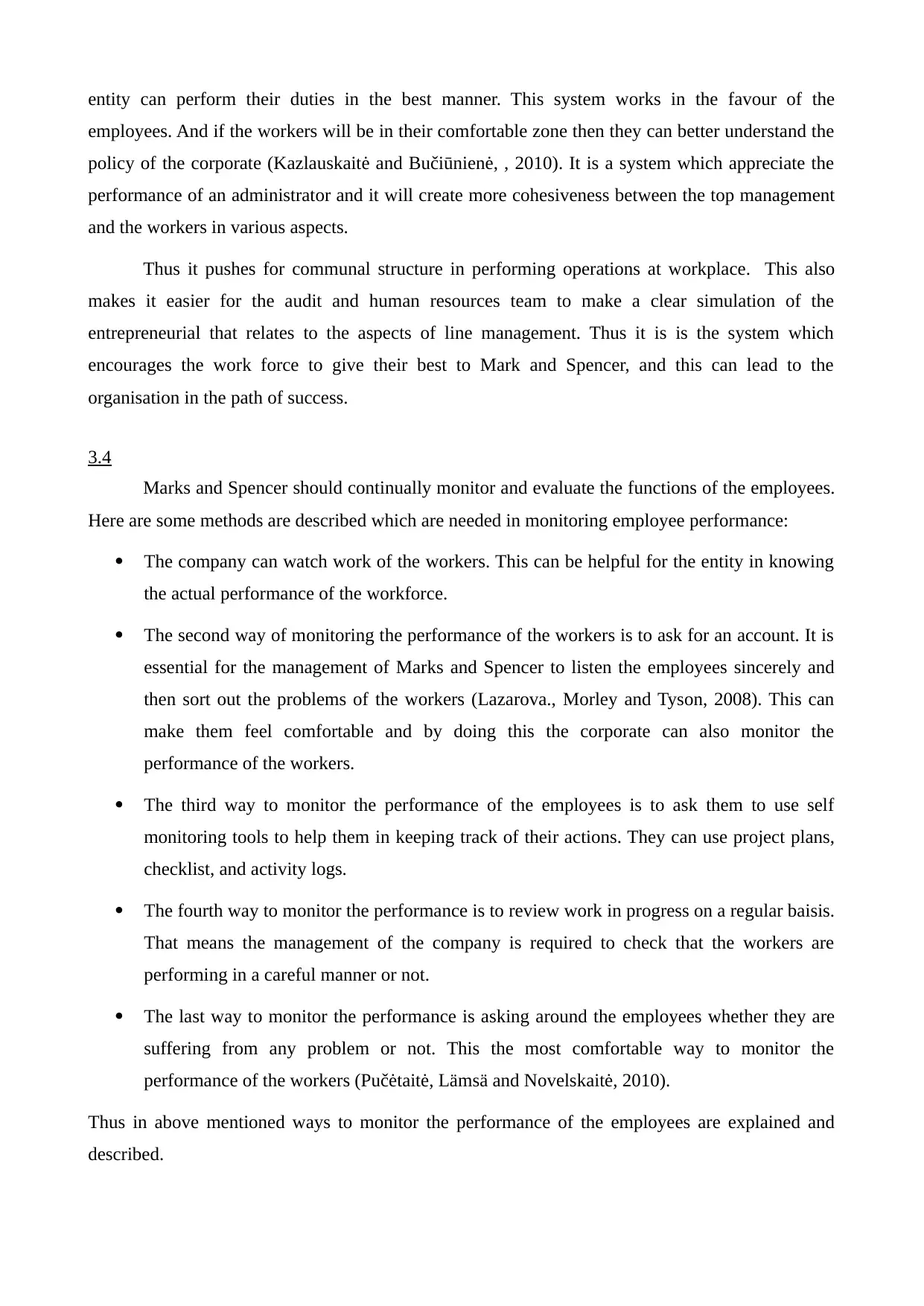
entity can perform their duties in the best manner. This system works in the favour of the
employees. And if the workers will be in their comfortable zone then they can better understand the
policy of the corporate (Kazlauskaitė and Bučiūnienė, , 2010). It is a system which appreciate the
performance of an administrator and it will create more cohesiveness between the top management
and the workers in various aspects.
Thus it pushes for communal structure in performing operations at workplace. This also
makes it easier for the audit and human resources team to make a clear simulation of the
entrepreneurial that relates to the aspects of line management. Thus it is is the system which
encourages the work force to give their best to Mark and Spencer, and this can lead to the
organisation in the path of success.
3.4
Marks and Spencer should continually monitor and evaluate the functions of the employees.
Here are some methods are described which are needed in monitoring employee performance:
The company can watch work of the workers. This can be helpful for the entity in knowing
the actual performance of the workforce.
The second way of monitoring the performance of the workers is to ask for an account. It is
essential for the management of Marks and Spencer to listen the employees sincerely and
then sort out the problems of the workers (Lazarova., Morley and Tyson, 2008). This can
make them feel comfortable and by doing this the corporate can also monitor the
performance of the workers.
The third way to monitor the performance of the employees is to ask them to use self
monitoring tools to help them in keeping track of their actions. They can use project plans,
checklist, and activity logs.
The fourth way to monitor the performance is to review work in progress on a regular baisis.
That means the management of the company is required to check that the workers are
performing in a careful manner or not.
The last way to monitor the performance is asking around the employees whether they are
suffering from any problem or not. This the most comfortable way to monitor the
performance of the workers (Pučėtaitė, Lämsä and Novelskaitė, 2010).
Thus in above mentioned ways to monitor the performance of the employees are explained and
described.
employees. And if the workers will be in their comfortable zone then they can better understand the
policy of the corporate (Kazlauskaitė and Bučiūnienė, , 2010). It is a system which appreciate the
performance of an administrator and it will create more cohesiveness between the top management
and the workers in various aspects.
Thus it pushes for communal structure in performing operations at workplace. This also
makes it easier for the audit and human resources team to make a clear simulation of the
entrepreneurial that relates to the aspects of line management. Thus it is is the system which
encourages the work force to give their best to Mark and Spencer, and this can lead to the
organisation in the path of success.
3.4
Marks and Spencer should continually monitor and evaluate the functions of the employees.
Here are some methods are described which are needed in monitoring employee performance:
The company can watch work of the workers. This can be helpful for the entity in knowing
the actual performance of the workforce.
The second way of monitoring the performance of the workers is to ask for an account. It is
essential for the management of Marks and Spencer to listen the employees sincerely and
then sort out the problems of the workers (Lazarova., Morley and Tyson, 2008). This can
make them feel comfortable and by doing this the corporate can also monitor the
performance of the workers.
The third way to monitor the performance of the employees is to ask them to use self
monitoring tools to help them in keeping track of their actions. They can use project plans,
checklist, and activity logs.
The fourth way to monitor the performance is to review work in progress on a regular baisis.
That means the management of the company is required to check that the workers are
performing in a careful manner or not.
The last way to monitor the performance is asking around the employees whether they are
suffering from any problem or not. This the most comfortable way to monitor the
performance of the workers (Pučėtaitė, Lämsä and Novelskaitė, 2010).
Thus in above mentioned ways to monitor the performance of the employees are explained and
described.

TASK 4
4.1
In the given case Faisal is terminated from the job because he was not paying attention on
his workings. He was an experienced man this is the reason that Bod hired him, but later it is found
that Faisal was not performing his activities and he was not operating his duties in a professional
manner. Therefore the Bob had to terminate him. As per the given scenario Bob has opened a
restaurant named Chicken Master which is situated at Gants Hill. He alone is not able to manage all
the operations theretofore he appointed Faisal (Tanova and Nadir, 2010). But the appointed
manager is not operating his services in a proper manner, as he is using the official gazettes for his
personal use which is not mentioned in his contract of employment and the other thing is that he has
focuses on his own business not on his employer's. Thus at last the Bob has to terminate him from
the job due to his irresponsibilities and ignorance.
4.2
Exit procedure which is opted by Chicken Master is mentioned as under:
The employee who is resigning is to give a resignation letter to the supervisor and
management of the company.
After then an exit link is to be sent on the mail id of the exiting employee.
An exit form is to be submitted by the worker through the link.
After this the the worker is to click on submit button, to send form electronically to the
supervisor.
After this an exit interview is conducted (BriscoeSchuler and Tarique,2012).
The worker has to turn in his employee ID badge, proxy card and all other district owned
materials.
At the management will complete their portion of the exit form and submit it to the HR
department.
Thus in above mentioned way the whole process of exit of an employee is being completed.
4.3
Employment legislation deals with the body of laws that helps to maintain smooth
relationship between employees and employers. Issue involving discrimination, legal working ages
and safe working conditions are involved by the legislation. Some of laws are stated below:
4.1
In the given case Faisal is terminated from the job because he was not paying attention on
his workings. He was an experienced man this is the reason that Bod hired him, but later it is found
that Faisal was not performing his activities and he was not operating his duties in a professional
manner. Therefore the Bob had to terminate him. As per the given scenario Bob has opened a
restaurant named Chicken Master which is situated at Gants Hill. He alone is not able to manage all
the operations theretofore he appointed Faisal (Tanova and Nadir, 2010). But the appointed
manager is not operating his services in a proper manner, as he is using the official gazettes for his
personal use which is not mentioned in his contract of employment and the other thing is that he has
focuses on his own business not on his employer's. Thus at last the Bob has to terminate him from
the job due to his irresponsibilities and ignorance.
4.2
Exit procedure which is opted by Chicken Master is mentioned as under:
The employee who is resigning is to give a resignation letter to the supervisor and
management of the company.
After then an exit link is to be sent on the mail id of the exiting employee.
An exit form is to be submitted by the worker through the link.
After this the the worker is to click on submit button, to send form electronically to the
supervisor.
After this an exit interview is conducted (BriscoeSchuler and Tarique,2012).
The worker has to turn in his employee ID badge, proxy card and all other district owned
materials.
At the management will complete their portion of the exit form and submit it to the HR
department.
Thus in above mentioned way the whole process of exit of an employee is being completed.
4.3
Employment legislation deals with the body of laws that helps to maintain smooth
relationship between employees and employers. Issue involving discrimination, legal working ages
and safe working conditions are involved by the legislation. Some of laws are stated below:
⊘ This is a preview!⊘
Do you want full access?
Subscribe today to unlock all pages.

Trusted by 1+ million students worldwide
1 out of 15
Related Documents
Your All-in-One AI-Powered Toolkit for Academic Success.
+13062052269
info@desklib.com
Available 24*7 on WhatsApp / Email
![[object Object]](/_next/static/media/star-bottom.7253800d.svg)
Unlock your academic potential
Copyright © 2020–2025 A2Z Services. All Rights Reserved. Developed and managed by ZUCOL.





